Synaptic Connections#
@Tianqiu Zhang @Xiaoyu Chen @Sichao He
Synaptic connections is an essential part for building a neural dynamic system. BrainPy provides several commonly used connection methods in the brainpy.connect module (which can be accessed by the shortcut bp.conn) that can help users to easily construct many types of synaptic connection, inclulding built-in and self-customized connectors.
An Overview of BrainPy Connectors#
Here we provide an overview of BrainPy connectors.
Connector.require()#
This method returns the connection properties required by users. The connection properties are elaborated in the following sections in detail. Here is a brief summary of the connection properties users can require.
Connection properties |
Structure |
Definition |
|---|---|---|
|
2-D array (matrix) |
Dense connection matrix |
|
1-D array (vector) |
Indices of the pre-synaptic neuron group |
|
1-D array (vector) |
Indices of the post-synaptic neuron group |
|
tuple (vector, vector) |
The post-synaptic neuron indices and the corresponding pre-synaptic neuron pointers |
|
tuple (vector, vector) |
The pre-synaptic neuron indices and the corresponding post-synaptic neuron pointers |
|
tuple (vector, vector) |
The synapse indices sorted by pre-synaptic neurons and corresponding pre-synaptic neuron pointers |
|
tuple (vector, vector) |
The synapse indices sorted by post-synaptic neurons and corresponding post-synaptic neuron pointers |
Users can implement this method by following sentence:
pre_ids, post_ids, pre2post, conn_mat = conn.require('pre_ids', 'post_ids', 'pre2post', 'conn_mat')
Note
Note that this method can return multiple connection properties.
Connection Properties#
There are multiple connection properties that can be required by users.
1. conn_mat#
The matrix-based synaptic connection is one of the most intuitive ways to build synaptic computations. The connection matrix between two neuron groups can be easily obtained through the function of connector.requires('conn_mat'). Each connection matrix is an array with the shape of \((n_{pre}, n_{post})\):

2. pre_ids and post_ids#
Using vectors to store the connection between neuron groups is a much more efficient way to reduce memory when the connection matrix is sparse. For the connction matrix conn_mat defined above, we can align the connected pre-synaptic neurons and the post-synaptic neurons by two one-dimensional arrays: pre_ids and post_ids.

In this way, we only need two vectors (pre_ids and post_ids) to store the synaptic connection. syn_id in the figure indicates the indices of each neuron pair, i.e. each synapse.
3. pre2post and post2pre#
Another two synaptic structures are pre2post and post2pre. They establish the mapping between the pre- and post-synaptic neurons.
pre2post is a tuple containing two vectors, one of which is the post-synaptic neuron indices and the other is the corresponding pre-synaptic neuron pointers. For example, the following figure shows the indices of the pre-synaptic neurons and the post-synaptic neurons to which the pre-synaptic neurons project:

To record the connection, firstly the post_ids are concatenated as a single vector call the post-synaptic index vector (indices). Because the post-synaptic neuron indices have been sorted by the pre-synaptic neuron indices, it is sufficient to record only the starting position of each pre-synaptic neuron index. Therefore, the pre-synaptic neuron indices and the end of the last pre-synaptic neuron index together make up the pre-synaptic index pointer vector (indptr), which is illustrated in the figure below.

The post-synaptic neuron indices to which pre-synaptic neuron \(i\) projects can be obtained by array slicing:
indices[indptr[i], indptr[i+1]]
Similarly, post2pre is a 2-element tuple containing the pre-synaptic neuron indices and the corresponding post-synaptic neuron pointers. Taking the connection in the illutration aobve as an example, the post-synaptic neuron indices and the pre-synaptic neuron indices to which the post-synaptic neurons project is shown as:
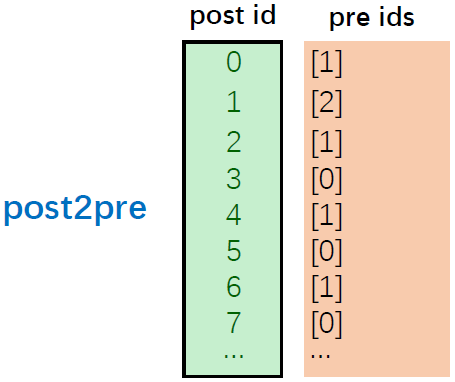
The pre-synaptic index vector (indices) and the post-synaptic index pointer vector (indptr) are listed below:

When the connection is sparse, pre2post (or post2pre) is a very efficient way to store the connection, since the lengths of the two vectors in the tuple are \(n_{synapse}\) and \(n_{pre}\) (\(n_{post}\)), respectively.
4. pre2syn and post2syn#
The last two properties are pre2syn and post2syn that record pre- and post-synaptic projection, respectively.
For pre2syn, similar to pre2post and post2pre, there is a synapse index vector and a pre-synaptic index pointer vector that refers to the starting position of each pre-synaptic neuron index at the synapse index vector.
Below is the same example identifying the connection by pre-synaptic neuron indices and the synapses belonging to them.

For better understanding, The synapse indices, pre- and post-synaptic neuron indices are shown as below:

The pre-synaptic index pointer vector is computed in the same way as in pre2post:

Similarly, post2syn is a also tuple containing the synapse neuron indices and the corresponding post-synaptic neuron pointers.
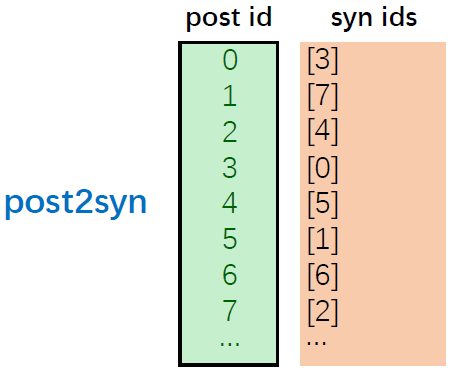
The only different from pre2syn is that the synapse indices is (most of the time) originally sorted by pre-synaptic neurons, but when computing post2syn, synapses should be sorted by post-synaptic neuron indices:

The synapse index vector (the first row) and the post-synaptic index pointer vector (the last row) are listed below:

import brainpy as bp
import brainpy.math as bm
bp.math.set_platform('cpu')
bp.__version__
'2.4.0'
import networkx as nx
import numpy as np
import matplotlib.pyplot as plt
Built-in regular connections#
brainpy.connect.One2One#
The neurons in the pre-synaptic neuron group only connect to the neurons in the same position of the post-synaptic group. Thus, this connection requires the indices of two neuron groups same. Otherwise, an error will occurs.

conn = bp.connect.One2One()
conn(pre_size=10, post_size=10)
One2One
where pre_size denotes the size of the pre-synaptic neuron group, post_size denotes the size of the post-synaptic neuron group.
Note that parameter size can be int, tuple of int or list of int where each element represent each dimension of neuron group.
In One2One connection, particularly, pre_size and post_size must be the same.
Class One2One is inherited from TwoEndConnector. Users can use method require or requires to get specific connection properties.
Here is an example:
size = 5
conn = bp.connect.One2One()(pre_size=size, post_size=size)
res = conn.require('pre_ids', 'post_ids', 'pre2post', 'conn_mat')
print('pre_ids:', res[0])
print('post_ids:', res[1])
print('pre2post:', res[2])
WARNING:absl:No GPU/TPU found, falling back to CPU. (Set TF_CPP_MIN_LOG_LEVEL=0 and rerun for more info.)
pre_ids: [0 1 2 3 4]
post_ids: [0 1 2 3 4]
pre2post: (DeviceArray([0, 1, 2, 3, 4], dtype=int32), DeviceArray([0, 1, 2, 3, 4, 5], dtype=int32))
brainpy.connect.All2All#
All neurons of the post-synaptic population form connections with all
neurons of the pre-synaptic population (dense connectivity). Users can
choose whether connect the neurons at the same position
(include_self=True or False).

conn = bp.connect.All2All(include_self=False)
conn(pre_size=size, post_size=size)
All2All(include_self=False)
Class All2All is inherited from TwoEndConnector. Users can use method require or requires to get specific connection properties.
Here is an example:
conn = bp.connect.All2All(include_self=False)(pre_size=size, post_size=size)
res = conn.require('pre_ids', 'post_ids', 'pre2post', 'conn_mat')
print('pre_ids:', res[0])
print('post_ids:', res[1])
print('pre2post:', res[2])
print('conn_mat:', res[3])
pre_ids: [0 0 0 0 1 1 1 1 2 2 2 2 3 3 3 3 4 4 4 4]
post_ids: [1 2 3 4 0 2 3 4 0 1 3 4 0 1 2 4 0 1 2 3]
pre2post: (DeviceArray([1, 2, 3, 4, 0, 2, 3, 4, 4, 3, 1, 0, 0, 1, 2, 4, 0, 1, 2, 3], dtype=int32), DeviceArray([ 0, 4, 8, 12, 16, 20], dtype=int32))
conn_mat: [[False True True True True]
[ True False True True True]
[ True True False True True]
[ True True True False True]
[ True True True True False]]
brainpy.connect.GridFour#
GridFour is the four nearest neighbors connection. Each neuron connect to its
nearest four neurons.

conn = bp.connect.GridFour(include_self=False)
conn(pre_size=size)
GridFour(include_self=False, periodic_boundary=False)
Class GridFour is inherited from OneEndConnector, therefore there is only one parameter pre_size representing the size of neuron group, which should be two-dimensional geometry.
Here is an example:
size = (4, 4)
conn = bp.connect.GridFour(include_self=False)(pre_size=size)
res = conn.require('pre_ids', 'conn_mat')
print('pre_ids', res[0])
pre_ids [ 0 0 1 1 1 2 2 2 3 3 4 4 4 5 5 5 5 6 6 6 6 7 7 7
8 8 8 9 9 9 9 10 10 10 10 11 11 11 12 12 13 13 13 14 14 14 15 15]
# Using NetworkX to visualize network connection
G = nx.from_numpy_matrix(res[1])
nx.draw(G, with_labels=True)
plt.show()
---------------------------------------------------------------------------
AttributeError Traceback (most recent call last)
Cell In[11], line 2
1 # Using NetworkX to visualize network connection
----> 2 G = nx.from_numpy_matrix(res[1])
3 nx.draw(G, with_labels=True)
4 plt.show()
AttributeError: module 'networkx' has no attribute 'from_numpy_matrix'
brainpy.connect.GridEight#
GridEight is eight nearest neighbors connection. Each neuron connect to its
nearest eight neurons.

conn = bp.connect.GridEight(include_self=False)
conn(pre_size=size)
Class GridEight is inherited from GridN, which will be introduced as followed.
Here is an example:
size = (4, 4)
conn = bp.connect.GridEight(include_self=False)(pre_size=size)
res = conn.require('pre_ids', 'conn_mat')
print('pre_ids', res[0])
Take the central point (id = 4) as an example, its neighbors are all the other point except itself.
Therefore, its row in conn_mat has True for all values except itself.
# Using NetworkX to visualize network connection
G = nx.from_numpy_matrix(res[1])
nx.draw(G, with_labels=True)
plt.show()
brainpy.connect.GridN#
GridN is also a nearest neighbors connection. Each neuron connect to its
nearest \((2N+1) \cdot (2N+1)\) neurons (if including itself).
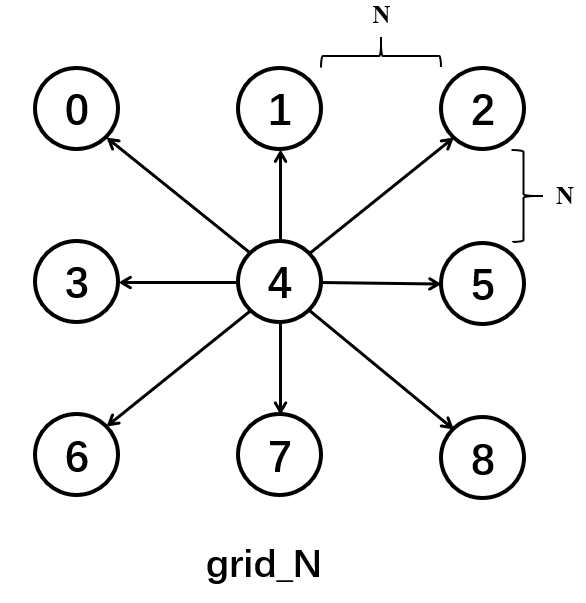
Here are some examples to fully understand GridN. It is slightly different from GridEight: GridEight is equivalent to GridN when N = 1.
When N = 1: \(\begin{bmatrix} x & x & x\\ x & I & x\\ x & x & x \end{bmatrix}\)
When N = 2: \( \begin{bmatrix} x & x & x & x & x\\ x & x & x & x & x\\ x & x & I & x & x\\ x & x & x & x & x\\ x & x & x & x & x \end{bmatrix} \)
conn = bp.connect.GridN(N=2, include_self=False)
conn(pre_size=size)
Here is an example:
size = (4, 4)
conn = bp.connect.GridN(N=1, include_self=False)(pre_size=size)
res = conn.require('conn_mat')
# Using NetworkX to visualize network connection
G = nx.from_numpy_matrix(res)
nx.draw(G, with_labels=True)
plt.show()
Built-in random connections#
brainpy.connect.FixedProb#
For each post-synaptic neuron, there is a fixed probability that it forms a connection with a neuron of the pre-synaptic population. It is basically a all_to_all projection, except some synapses are not created, making the projection sparser.
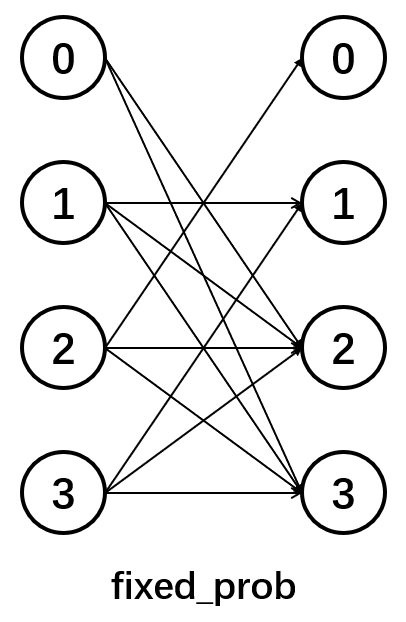
Class brainpy.connect.FixedProb is inherited from TwoEndConnector, and it receives three settings:
prob: Fixed probability for connection with a pre-synaptic neuron for each post-synaptic neuron.pre_ratio: The ratio of pre-synaptic neurons to connect.include_self: Whether connect to inself.allow_multi_conn: Whether allow one pre-synaptic neuron connects to multiple post-synaptic neurons.seed: Seed the random generator.
And there are two parameters passed in for calling instance of class: pre_size and post_size.
conn = bp.connect.FixedProb(prob=0.5, include_self=False, seed=134)
conn(pre_size=4, post_size=4)
conn.require('conn_mat')
brainpy.connect.FixedPreNum#
Each neuron in the post-synaptic population receives connections from a fixed number of neurons of the pre-synaptic population chosen randomly. It may happen that two post-synaptic neurons are connected to the same pre-synaptic neuron and that some pre-synaptic neurons are connected to nothing.

Class brainpy.connect.FixedPreNum is inherited from TwoEndConnector, and it receives three settings:
num: The conn probability (if “num” is float) or the fixed number of connectivity (if “num” is int).include_self: Whether connect to inself.allow_multi_conn: Whether allow one pre-synaptic neuron connects to multiple post-synaptic neurons.seed: Seed the random generator.
And there are two parameters passed in for calling instance of class: pre_size and post_size.
conn = bp.connect.FixedPreNum(num=2, include_self=True, seed=1234)
conn(pre_size=4, post_size=4)
conn.require('conn_mat')
brainpy.connect.FixedPostNum#
Each neuron in the pre-synaptic population sends a connection to a fixed number of neurons of the post-synaptic population chosen randomly. It may happen that two pre-synaptic neurons are connected to the same post-synaptic neuron and that some post-synaptic neurons receive no connection at all.
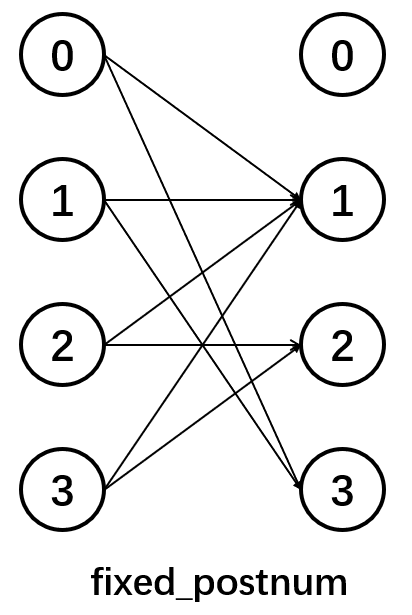
Class brainpy.connect.FixedPostNum is inherited from TwoEndConnector, and it receives three settings:
num: The conn probability (if “num” is float) or the fixed number of connectivity (if “num” is int).allow_multi_conn: Whether allow one pre-synaptic neuron connects to multiple post-synaptic neurons.include_self: Whether connect to inself.seed: Seed the random generator.
And there are two parameters passed in for calling instance of class: pre_size and post_size.
conn = bp.connect.FixedPostNum(num=2, include_self=True, seed=1234)
conn(pre_size=4, post_size=4)
conn.require('conn_mat')
brainpy.connect.FixedTotalNum#
Connections between pre-synaptic and post-synaptic neurons are determined by a specified total number or propotion of connections.
Class brainpy.connect.FixedTotalNum is inherited from TwoEndConnector, and it receives two settings:
num: The total number of connections (if “num” is float) or the fixed number of connectivity (if “num” is int).allow_multi_conn: Whether allow one pre-synaptic neuron connects to multiple post-synaptic neurons.seed: Seed the random generator.
And there are two parameters passed in for calling instance of class: pre_size and post_size.
conn = bp.connect.FixedTotalNum(num=8, allow_multi_conn=False, seed=1234)
conn(pre_size=3, post_size=4)
conn.require('conn_mat')
brainpy.connect.GaussianProb#
Builds a Gaussian connection pattern between the two populations, where the connection probability decay according to the gaussian function.
Specifically,
where \((x, y)\) is the position of the pre-synaptic neuron and \((x_c,y_c)\) is the position of the post-synaptic neuron.
For example, in a \(30 \textrm{x} 30\) two-dimensional networks, when \(\beta = \frac{1}{2\sigma^2} = 0.1\), the connection pattern is shown as the follows:
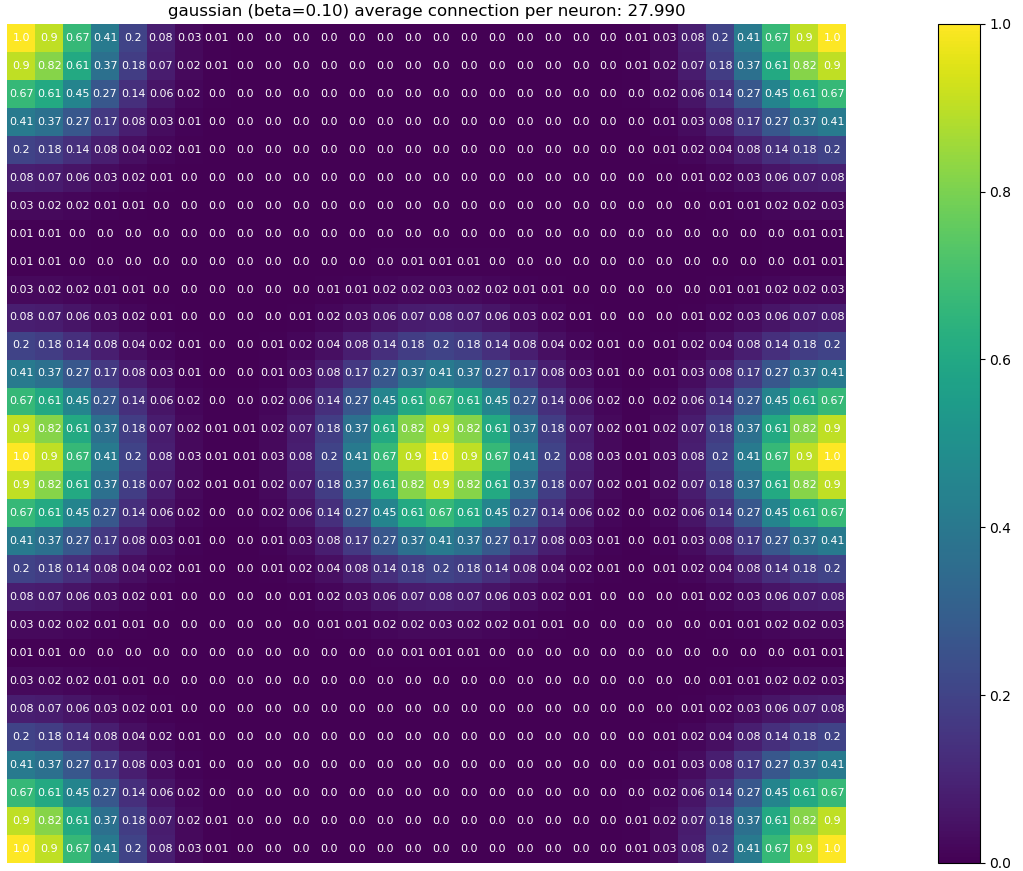
GaussianProb is inherited from OneEndConnector, and it receives four settings:
sigma: (float) Width of the Gaussian function.encoding_values: (optional, list, tuple, int, float) The value ranges to encode for neurons at each axis.periodic_boundary: (bool) Whether the neuron encode the value space with the periodic boundary.normalize: (bool) Whether normalize the connection probability.include_self: (bool) Whether create the conn at the same position.seed: (bool) The random seed.
conn = bp.connect.GaussianProb(sigma=2, periodic_boundary=True, normalize=True, include_self=True, seed=21)
conn(pre_size=10)
conn.require('conn_mat')
# Using NetworkX to visualize network connection
G = nx.from_numpy_matrix(conn.require('conn_mat'))
nx.draw(G, with_labels=True)
plt.show()
brainpy.connect.ProbDist#
Establishes a distance-based connection pattern between two populations, where the connection probability is contingent upon whether the actual distance between neurons is less than or equal to a given dist. If the distance between two neurons is less than or equal to dist, they have a connection probability of prob. For pre-synaptic neurons, only a proportion specified by pre_ratio will attempt to connect to post-synaptic neurons.
Specifically, Given two points, \(P_1\) and \(P_2\) in \(n\) -dimensional space:
The distance \(d\) between them in an \(n\) -dimensional space can be computed as:
In a vectorized form, this can be expressed as:
This general formula calculates the Euclidean distance between two points in ( n )-dimensional space and is valid for any dimension ( n ).
In the context of the provided code:
\(P_1\) would be the position of the pre-synaptic neuron.
\(P_2\) would be the position of each post-synaptic neuron being considered.
The decision to connect the neurons is then based on:
The distance \(d\) should be less than or equal to
dist.Random generation based on the
probparameter.
ProbDist is inherited from TwoEndConnector, and it receives four settings:
dist: (float, int) The maximum distance between two points.prob: (float) The connection probability, within 0. and 1.pre_ratio: (float) The ratio of pre-synaptic neurons to connect.seed: (optional, int) The random seed.include_self: Whether include the point at the same position.
conn = bp.connect.ProbDist(dist=10, prob=0.5, pre_ratio=0.5, seed=1234, include_self=True)
conn(pre_size=100, post_size=100)
mat = conn.require("conn_mat")
brainpy.connect.SmallWorld#
SmallWorld is a connector class to help build a small-world network [1]. small-world network is defined to be a network where the typical distance L between two randomly chosen nodes (the number of steps required) grows proportionally to the logarithm of the number of nodes N in the network, that is:
[1] Duncan J. Watts and Steven H. Strogatz, Collective dynamics of small-world networks, Nature, 393, pp. 440–442, 1998.
Currently, SmallWorld only support a one-dimensional network with the ring structure. It receives four settings:
num_neighbor: the number of the nearest neighbors to connect.prob: the probability of rewiring each edge.directed: whether the edge is the directed (“directed=True”) or undirected (“directed=False”) connection.include_self: whether allow to connect to itself.
conn = bp.connect.SmallWorld(num_neighbor=5, prob=0.2, directed=False, include_self=False)
conn(pre_size=10, post_size=10)
conn.require('conn_mat')
# Using NetworkX to visualize network connection
G = nx.from_numpy_matrix(conn.require('conn_mat'))
nx.draw(G, with_labels=True)
plt.show()
brainpy.connect.ScaleFreeBA#
ScaleFreeBA is a connector class to help build a random scale-free network according to the Barabási–Albert preferential attachment model [2]. ScaleFreeBA receives the following settings:
m: Number of edges to attach from a new node to existing nodes.directed: whether the edge is the directed (“directed=True”) or undirected (“directed=False”) connection.seed: Indicator of random number generation state.
[2] A. L. Barabási and R. Albert “Emergence of scaling in random networks”, Science 286, pp 509-512, 1999.
conn = bp.connect.ScaleFreeBA(m=5, directed=False, seed=12345)
conn(pre_size=10, post_size=10)
conn.require('conn_mat')
# Using NetworkX to visualize network connection
G = nx.from_numpy_matrix(conn.require('conn_mat'))
nx.draw(G, with_labels=True)
plt.show()
brainpy.connect.ScaleFreeBADual#
ScaleFreeBADual is a connector class to help build a random scale-free network according to the dual Barabási–Albert preferential attachment model [3]. ScaleFreeBA receives the following settings:
p: The probability of attaching \(m_1\) edges (as opposed to \(m_2\) edges).m1: Number of edges to attach from a new node to existing nodes with probability \(p\).m2: Number of edges to attach from a new node to existing nodes with probability \(1-p\).directed: whether the edge is the directed (“directed=True”) or undirected (“directed=False”) connection.seed: Indicator of random number generation state.
[3] N. Moshiri. “The dual-Barabasi-Albert model”, arXiv:1810.10538.
conn = bp.connect.ScaleFreeBADual(m1=3, m2=5, p=0.5, directed=False, seed=12345)
conn(pre_size=10, post_size=10)
conn.require('conn_mat')
brainpy.connect.PowerLaw#
PowerLaw is a connector class to help build a random graph with powerlaw degree distribution and approximate average clustering [4]. It receives the following settings:
m: the number of random edges to add for each new nodep: Probability of adding a triangle after adding a random edgedirected: whether the edge is the directed (“directed=True”) or undirected (“directed=False”) connection.seed: Indicator of random number generation state.
[4] P. Holme and B. J. Kim, “Growing scale-free networks with tunable clustering”, Phys. Rev. E, 65, 026107, 2002.
conn = bp.connect.PowerLaw(m=3, p=0.5, directed=False, seed=12345)
conn(pre_size=10, post_size=10)
conn.require('conn_mat')
Encapsulate your existing connections#
BrainPy also allows users to encapsulate existing connections with convenient class interfaces. Users can provide connection types as:
Index projection;
Dense matrix;
Sparse matrix.
Then users should provide pre_size and post_size information in order to instantiate the connection. In such a way, based on the following connection classes, users can generate any other synaptic structures (such like pre2post, pre2syn, conn_mat, etc.) easily.
bp.conn.IJConn#
Here, let’s take a simple connection as an example. In this example, we create a connection which receives users’ handful index projection by using bp.conn.IJConn.
pre_list = np.array([0, 1, 2])
post_list = np.array(([0, 0, 0]))
conn = bp.conn.IJConn(i=pre_list, j=post_list)
conn = conn(pre_size=5, post_size=3)
conn.requires('conn_mat')
conn.requires('pre2post')
conn.requires('pre2syn')
bp.conn.MatConn#
In next example, we create a connection which receives user’s handful dense connection matrix by using bp.conn.MatConn.
bp.math.random.seed(123)
conn = bp.connect.MatConn(conn_mat=np.random.randint(2, size=(5, 3), dtype=bp.math.bool_))
conn = conn(pre_size=5, post_size=3)
conn.requires('conn_mat')
conn.requires('pre2post')
conn.require('pre2syn')
bp.conn.SparseMatConn#
In last example, we create a connection which receives user’s handful sparse connection matrix by using bp.conn.sparseMatConn
from scipy.sparse import csr_matrix
conn_mat = np.random.randint(2, size=(5, 3), dtype=bp.math.bool_)
sparse_mat = csr_matrix(conn_mat)
conn = bp.conn.SparseMatConn(sparse_mat)
conn = conn(pre_size=sparse_mat.shape[0], post_size=sparse_mat.shape[1])
conn.requires('conn_mat')
conn.requires('pre2post')
conn.requires('post2syn')
Using NetworkX to provide connections and pass into Connector#
NetworkX is a Python package for the creation, manipulation, and study of the structure, dynamics, and functions of complex networks.
Users can design their own complex netork by using NetworkX.
import networkx as nx
G = nx.Graph()
By definition, a Graph is a collection of nodes (vertices) along with identified pairs of nodes (called edges, links, etc).
To learn more about NetowrkX, please check the official documentation: NetworkX tutorial
Using class brainpy.connect.MatConn to construct connections is recommended here.
Dense adjacency matrix: a two-dimensional ndarray.
Here gives an example to illustrate how to transform a random graph into your synaptic connections by using dense adjacency matrix.
G = nx.fast_gnp_random_graph(5, 0.5) # initialize a random graph G
B = nx.adjacency_matrix(G)
A = np.array(nx.adjacency_matrix(G).todense()) # get dense adjacency matrix of G
print('dense adjacency matrix:')
print(A)
nx.draw(G, with_labels=True)
plt.show()
Users can use class MatConn inherited from TwoEndConnector to construct connections. A dense adjacency matrix should be passed in when initializing MatConn class.
Note that when calling the instance of the class, users should pass in two parameters: pre_size and post_size.
In this case, users can use the shape of dense adjacency matrix as the parameters.
conn = bp.connect.MatConn(A)(pre_size=A.shape[0], post_size=A.shape[1])
res = conn.require('conn_mat')
print(res)
Customize your connections#
BrainPy allows users to customize their connections. The following requirements should be satisfied:
Your connection class should inherit from
brainpy.connect.TwoEndConnectororbrainpy.connect.OneEndConnector.__init__function should be implemented and essential parameters should be initialized.Users should also overwrite
build_csr(),build_coo()orbuild_mat()function to describe how to build your connection.
Let’s take an example to illustrate the details of customization.
class FixedProb(bp.connect.TwoEndConnector):
"""Connect the post-synaptic neurons with fixed probability.
Parameters
----------
prob : float
The conn probability.
include_self : bool
Whether to create (i, i) connection.
seed : optional, int
Seed the random generator.
"""
def __init__(self, prob, include_self=True, seed=None):
super(FixedProb, self).__init__()
assert 0. <= prob <= 1.
self.prob = prob
self.include_self = include_self
self.seed = seed
self.rng = np.random.RandomState(seed=seed)
def build_csr(self):
ind = []
count = np.zeros(self.pre_num, dtype=np.uint32)
def _random_prob_conn(rng, pre_i, num_post, prob, include_self):
p = rng.random(num_post) <= prob
if (not include_self) and pre_i < num_post:
p[pre_i] = False
conn_j = np.asarray(np.where(p)[0], dtype=np.uint32)
return conn_j
for i in range(self.pre_num):
posts = _random_prob_conn(self.rng, pre_i=i, num_post=self.post_num,
prob=self.prob, include_self=self.include_self)
ind.append(posts)
count[i] = len(posts)
ind = np.concatenate(ind)
indptr = np.concatenate(([0], count)).cumsum()
return ind, indptr
Then users can initialize the your own connections as below:
conn = FixedProb(prob=0.5, include_self=True)(pre_size=5, post_size=5)
conn.require('conn_mat')

